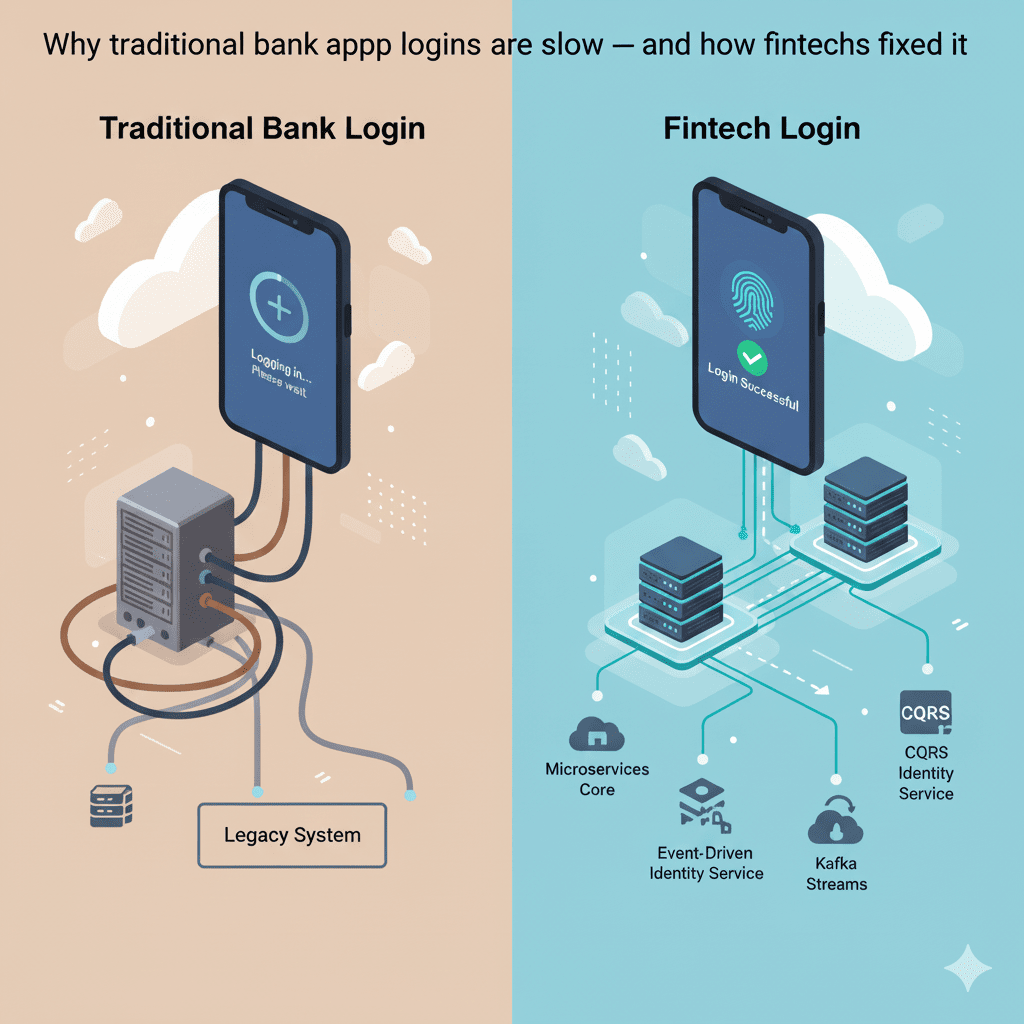Why Traditional Bank Apps in Nigeria Load Slowly — and Why Fintech Apps Feel Instant

Why Traditional Bank Apps in Nigeria Load Slowly — and Why Fintech Apps Feel Instant
Why are Nigeria bank app slow? Have you ever noticed that when you log in to some traditional Commercial bank’s mobile app in Nigeria, the screen loads for several seconds before showing your accounts info, balances, and recent transactions?
Yet these new fintech banks open almost instantly — even though they handle far more users and transactions every single day.
As someone who has worked as a backend engineer on some of these traditional banking systems, I can tell you from the inside:
👉 The difference lies in architecture and design.
🏦 How Most Traditional Banks Handle Sign-In
Here’s what typically happens behind the scenes when you log in to most traditional bank app:
-
Login request – The mobile frontend encrypts your credentials and sends them to the backend.
-
Authentication & Authorization – The backend decrypts the payload, validates your credentials, and confirms your permissions.
-
Service fan-out begins – The backend must now fetch your profile and account data:
-
It retrieves your user ID, maps it to a customer ID, and then calls another service to get your list of accounts.
-
Sometimes the API returns full details and balances. Other times, it returns just account numbers, forcing the backend to loop through each one to fetch details and balances individually.
-
-
Transaction history – The system then calls another service to fetch recent transactions. Many legacy cores don’t even have a “recent transactions” endpoint, so the app requests a date range and picks the last 20 records manually.
-
UI aggregation – Only after all these service calls complete does the backend assemble a response for the landing screen.
Each of these steps introduces latency. By the time your dashboard appears, the backend has made multiple serial calls — sometimes five, sometimes ten.
That’s why you wait. ⏳
🧠 It’s Not Always About Incompetent Engineers
So, are the engineers in these banks unaware that this is inefficient?
Not really. Many know exactly what’s wrong.
The real challenge is legacy systems.
Traditional core banking platforms were originally built to support branch operations — not mobile or digital channels.
Mobile apps and internet banking were added years later as extensions, not primary design goals.
Fintechs, on the other hand, built their cores around mobile-first experiences. Their entire architecture was designed for asynchronous communication, modern databases, and distributed scaling from day one.
🚫 Why Caching Won’t Help
When this topic comes up among engineers, I often hear:
“Why not use caching to make it faster?”
But caching doesn’t solve this problem — because in banking, freshness is important.
If a customer made a transaction one minute ago, they expect to see it the moment they log in. Showing a cached balance risks displaying stale data — unacceptable for customers.
Another suggestion:
“Let’s just increase CPU or RAM on the core banking servers.”
Sure, that may reduce latency slightly, but it’s not scalable. Most banks run on Oracle or other relational databases, which are hard to scale horizontally. Vertical scaling (adding more power to one server) is expensive and limited.
Fintechs, meanwhile, use document databases and Elasticsearch for their query layers — technologies built to scale horizontally and return data in milliseconds.
🧩 A Better Design: CQRS + Domain-Driven Architecture
To achieve low-latency sign-in and instant dashboards, modern systems use the CQRS (Command Query Responsibility Segregation) pattern — often combined with Domain-Driven Design (DDD) and event-driven architecture.
Here’s the core idea:
-
Commands (Writes) handle all data changes — transfers, deposits, profile updates.
-
Queries (Reads) are separated into their own optimized data stores, tuned for fast retrieval.
When a transaction occurs:
-
The system processes it on the command side (e.g., updating the ledger).
-
It then publishes an event (via Kafka or another message broker).
-
A Query Service listens to that event and updates its copy of the data — account balances, customer info, and recent transactions.
Over time, the query store always reflects the latest state — eventually consistent but nearly real-time.
⚡ The Result: Instant Login
When a user logs in:
-
The system authenticates and authorizes them.
-
Then, instead of calling multiple backend services, it queries just one source — the Query Service.
-
That single call returns everything: accounts, balances, and the top 20 recent transactions.
No service fan-out. No sequential calls. No waiting.
This design works best with document databases (like MongoDB or Elasticsearch), while your command side can remain relational (like PostgreSQL or Oracle).
It’s modern, efficient, and scalable.
🏁 Why Fintechs Lead the Way
Fintechs have a natural advantage here.
Because their platforms were built primarily for digital channels, they designed for:
-
Event-driven data synchronization
-
Horizontal scalability
-
Low-latency query stores
Traditional banks, however, must retrofit or integrate around existing cores — often proprietary core-banking systems that might not have been built for this kind of agility.
That’s why fintech apps open instantly, while traditional bank apps “load for a while.”
💬 Wrapping Up
The performance gap between fintechs and traditional banks isn’t really about who has better engineers—though fintechs often attract top talent—it’s primarily about architecture and what their technology stacks enable them to do.
Modern design patterns like CQRS, event-driven microservices, and Domain-Driven Design are what enable instant, reliable, and scalable customer experiences.
Some Nigerian banks are already on this path—modernizing their platforms, decoupling services, building their own core banking systems, and developing near real-time query layers.
If you’re one of the engineers working on this transformation, I’d love to hear how your team is approaching it.
Stay connected:
Follow me for build updates, architecture deep dives, and CodeTrip November highlights.
-
LinkedIn: linkedin.com/in/your-handle
-
X (Twitter): x.com/your-handle
-
YouTube: youtube.com/@TechAndCodingWithOla-tg9vg
-
GitHub: github.com/a-olamide

